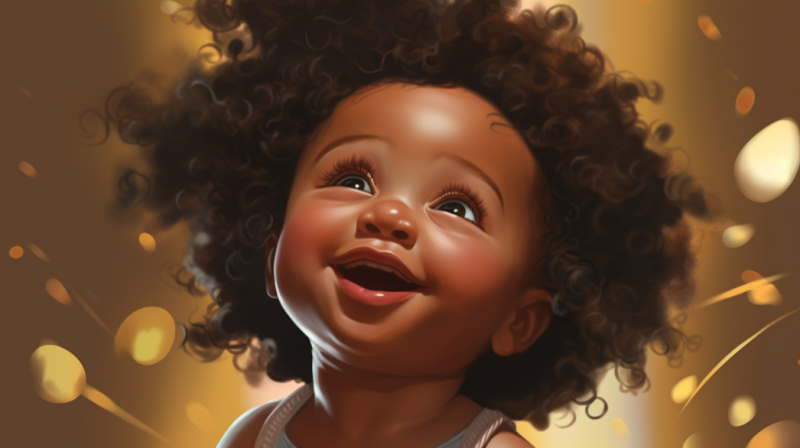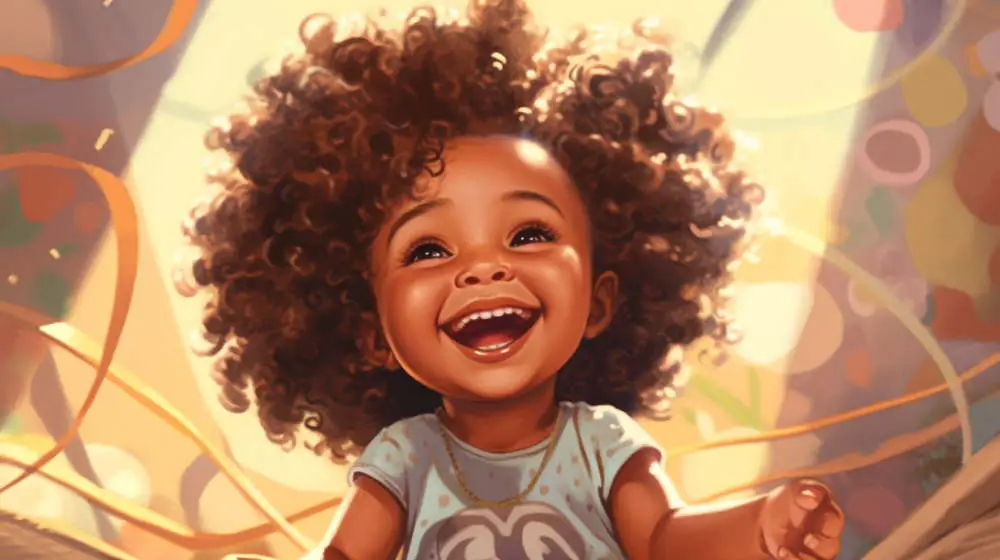When it comes to newborn hair, there’s a wide array of possibilities. Black babies are no exception, as their hair can vary significantly in texture and thickness. One common question is whether black babies are born with straight or curly hair? This topic aims to explore the different hair types seen in black newborns and the factors that contribute to this diversity.
Genetics plays a vital role in determining the appearance and texture of a baby’s hair at birth. While black babies typically have coarse, curly, or wavy hair, there are cases where a black baby can have straight hair. The genetic makeup of the parents and their ancestry contributes to the variety of hair textures found in black infants.
As babies grow and develop, hair texture can change. Many factors, including environmental and nutritional influences, can impact hair growth and texture over time. For some black babies, as they grow older, their hair may become curlier or coarser, while others may retain the same hair texture throughout their lives. In any case, it’s essential to recognize that the diversity of hair types in black newborns reflects the diverse and unique backgrounds of their families.
Genetics of Hair Texture
The texture of a person’s hair, whether it be straight, curly, or wavy, is primarily determined by their genetics. Hair texture is influenced by the genes inherited from both parents, as each parent contributes their own set of genes that determine the appearance of an individual’s hair. DNA plays a crucial role in defining the hair’s structure, ranging from straight to tightly coiled curls.
Straight, curly, and wavy hair are derived from the combination of alleles received from each parent. For example, a wavy-haired person can contribute either a curly or straight hair allele, with the offspring’s hair textures ranging from straight, wavy, or curly depending on the combination of alleles. It is essential to note that different combinations of these alleles result in varying hair textures.
Certain ethnic groups are more commonly associated with specific hair textures. For instance, people of African descent typically have tighter curls and coarser hair, while individuals of Asian origin typically have straight hair. However, it’s not uncommon for a black baby to be born with straight hair due to the complex nature of genetics and the mix of traits inherited from their parents.
Although the shape of a newborn’s hair can be influenced by genetics at birth, it may change as the baby grows. Straight or curly hair texture of the newborn might transform over time as external factors such as age, hormones, and environmental influences can also play a role in altering the hair’s structure.
In conclusion, genetics play a significant role in determining a person’s hair texture. Their genes, inherited from both parents, provide the blueprint for an individual’s hair type, with factors such as ethnicity and external influences possibly altering the appearance of their hair over time.

The Initial Hair Growth: What to Expect?
When it comes to hair growth in black babies, there is a wide range of possibilities. In many cases, black babies might be born with straight hair that could become curly over time. Hair texture is determined by a mix of genetics, and it’s entirely possible for a black baby to be born with straight hair. This is because straight hair is a genetic trait.
At birth, a newborn’s hair may vary in length and volume due to factors such as genetics and racial background. In some cases, the hair might appear sparse while for others, it may be thicker and more voluminous. It is completely normal for black babies to have different hair growth patterns during this stage.
In the first few months after birth, it is common for black babies to experience hair loss. This is due to the shedding of lanugo, the fine, soft hair that covers the fetus in the womb. According to What to Expect, the shedding of lanugo is a normal process and will be replaced by permanent hair that may have different properties compared to the baby’s initial hair growth.
Biracial babies’ hair might undergo several changes during the first few years of life. It is not uncommon for hair texture to evolve as the child grows, especially in the case of children with mixed racial backgrounds. A biracial baby’s hair can start changing from soon after birth to around age four, depending on their racial background.
In short, hair growth in black babies can differ greatly, with variations in texture, length, and volume. Keep in mind that changes throughout a child’s early years are normal and can be influenced by factors such as genetics and racial background. Always remember to be patient and understanding of these changes as the child grows and develops.
Changes in Baby Hair Over Time
Hair texture in babies can experience changes from the moment they are born and throughout their early years. It is common for black babies to be born with straight or wavy hair, which might become curlier or even coarser as they grow older.
During the first few months, a baby’s hair could change from being straight or wavy to adopting a curly pattern. This transition is not set in stone, as some babies might retain their straight hair texture, while others might develop curly or coarser hair over time. The process of hair texture change usually occurs gradually, rather than happening overnight.
Between birth and 4 years of age, a baby’s hair can go through considerable changes in terms of texture and thickness. Hair growth patterns might also vary from one child to another, with some experiencing faster growth than others. This growth could depend on factors such as genetics, diet, and hair care routine.
The scalp plays a critical role in the growth and texture changes taking place in a baby’s hair. As the baby grows, their scalp may experience fluctuations in oil production, which can influence the overall hair texture. It is essential to take good care of a baby’s scalp to support healthy hair growth and texture development.
In the case of biracial babies, hair texture transformations may continue until around age four. This period typically depends on the child’s racial background, which can be a mix of Caucasian, African, Latin, Asian, or other mixed heritages.
In summary, the hair texture of black and biracial babies may undergo considerable transformations over time, from straight or wavy hair to curly or coarser strands. These alterations might occur gradually or quicker in some children, influenced by genetics, scalp health, and other external factors. Parents should be ready to adapt to these changes and provide proper hair care to support their child’s developing hair texture.
Taking Care of Your Baby’s Hair
Caring for your baby’s hair requires a gentle approach, especially when it comes to black babies, as their hair texture might vary with some having tight curls, loose waves, or even nearly straight strands. Those with tighter curls and waves are more prone to breakage; thus, it’s crucial to give them special care.
To begin, wash your baby’s hair with a mild baby shampoo and lukewarm water, ideally once a week. Avoid using harsh soaps or shampoos that contain harmful chemicals. Gently massage the shampoo into the hair and scalp using your fingertips. This will help stimulate the hair follicles and promote healthy hair growth. Make sure to rinse the shampoo thoroughly to avoid any residue build-up.
Following the shampoo, apply a mild baby conditioner to help nourish the hair. The conditioning process can be especially beneficial for black babies since their hair tends to be more dry and prone to breakage. Remember to rinse the conditioner out thoroughly with lukewarm water too.
It is important to protect your baby’s hair from harsh environmental factors such as cold and heat. You can do this by securing your baby’s head with a soft bonnet or beanie during extreme weather or when outdoors. Additionally, avoid subjecting your baby’s hair to overly hot or cold water, as it may result in hair damage.
Finally, handling your black baby’s hair with care is the key to nurturing strong and healthy hair. By following these simple tips and providing your baby’s hair with the attention it requires, you can ensure that it remains strong and healthy as your baby grows.
Understanding Different Hair Textures
Hair comes in a variety of textures, which can be categorized as straight, wavy, curly, or kinky. These textures are determined by the shape of the hair follicle and the way hair grows out of the scalp. Hair texture can be further classified as fine, coarse, soft, or silky depending on the hair strand’s thickness and feel.
Straight hair is smooth and lacks obvious curls or waves. This hair type has round-shaped follicles, which allow hair to grow straight out of the scalp. Straight hair can be fine or coarse, depending on the individual, and is typically characterized by being smooth and sleek to the touch.
Wavy hair has a slight bend to it, creating an “S” shape down the length of the strand. This texture is not as smooth as straight hair but not as curly as curly hair. Wavy hair occurs when hair follicles are oval-shaped, resulting in hair strands with a slight curve.
Curly hair is characterized by tight curls, ringlets, or spirals. The hair follicles of curly hair are more oval-shaped than those of wavy hair, resulting in more pronounced curls. This hair texture can range from soft and bouncy to coarse and dense.
Kinky hair, common among individuals of African descent, has the tightest curls and is often referred to as coily or z-shaped. This hair texture is due to the very elliptical shape of the hair follicle, causing the hair strand to tightly coil around itself. Kinky hair can be fine or coarse, and its density can vary greatly.
In some cases, particularly with black babies, hair types can change during the early years of their life. At birth, a baby’s hair may be silky, straight, or slightly curly. However, as the child grows, their hair texture can change, transitioning from straight or wavy to curly or kinky hair (see Hello Motherhood or Chill Mama Chill for more information). Genetics play a significant role in determining hair texture, and different races have different genetic makeup that can affect hair types.
In summary, hair texture can range from straight to kinky and is influenced by the shape of hair follicles and the individual’s genetic makeup. It’s essential to recognize and understand these differences in hair texture in order to care for and maintain healthy hair.
Does the Month of Birth Affect the Texture of a Baby’s Hair?
According to September birth trivia facts, the month of birth does not affect the texture of a baby’s hair. Genetics and ethnic background play a more significant role in determining the texture of a baby’s hair. Factors such as diet and hair care routines also contribute to the overall health and texture of the baby’s hair.
Racial Differences in Hair Texture
Hair texture varies significantly across different ethnic groups, influenced by genetic factors and the shape of the hair follicle. Generally, there are three major racial groups with unique hair textures: Asians, Caucasians, and African-Americans.
Asians typically have straight hair with large, round follicles. This hair type is known for being smooth, silky, and often shiny, reflecting its consistent structure and evenly distributed sebum, the natural oil that protects and moisturizes hair. The dense nature of Asian hair provides strength and resilience, making it less prone to breakage.
Caucasians exhibit the most diverse hair textures, ranging from straight to wavy and curly. Their hair follicles tend to be oval-shaped, giving the hair strands more flexibility to take on various forms. However, this diversity in texture also makes Caucasian hair more susceptible to damage and frizz. Sebum production and distribution in Caucasian hair varies, which can impact overall hair health and appearance.
African-American hair is generally characterized by tight curls and kinks and grows almost parallel to the scalp, creating a coiled or spiral shape. This hair type has a flattened, elliptical hair follicle shape, which contributes to its distinct texture. African-American hair produces plenty of protective sebum, but the coiled structure makes it challenging for these oils to be distributed evenly, resulting in dry and brittle hair.
In summary, hair texture differences among Asians, Caucasians, and African-Americans can be attributed to the shape of their hair follicles and genetic factors. Understanding these differences is essential for proper hair care and maintenance in each ethnic group.
Frequently Asked Questions
What determines the texture of a baby’s hair at birth?
The texture of a baby’s hair at birth is primarily determined by genetics from both parents. In addition to genetic factors such as race and ethnicity, other factors like hormonal changes and the structure of hair follicles play a role in hair texture.
Is it possible for an African-American baby to be born with straight hair?
Yes, it is possible for an African-American baby to be born with straight hair. In fact, many black babies are born with straight hair, which might change texture over time as they grow, depending on their genetics and other factors.
When do babies typically develop their hair type?
Babies may start to develop their hair type within the first few months of life. However, it is important to note that a baby’s hair texture can continue to change over time due to various factors like growth, hormonal changes, and external factors.
Are biracial babies more likely to have curly or straight hair?
Biracial babies may have a variety of hair textures, ranging from straight to curly or wavy. Their hair type depends on the genetic traits they inherit from both parents. One example discusses how some biracial babies are born with straight hair, and it may start to curl around two months of age. However, it is essential to remember that each baby is unique, and their hair texture can change over time.
Do hair types change as a baby grows?
Yes, a baby’s hair can change from straight to curly or vice versa as they grow. Many factors can lead to a change in hair texture, such as hormonal changes, environmental factors, and the baby’s growth and development.
How can genetics play a role in a newborn’s hair texture?
Genetics play a significant role in determining a newborn’s hair texture by dictating the specific characteristics of hair like curl pattern, thickness, and structure. Hair texture traits are inherited from both parents, and variations in these traits might result in different hair textures among siblings. So, a newborn’s hair texture is influenced by a mix of genetic factors from both parents.



